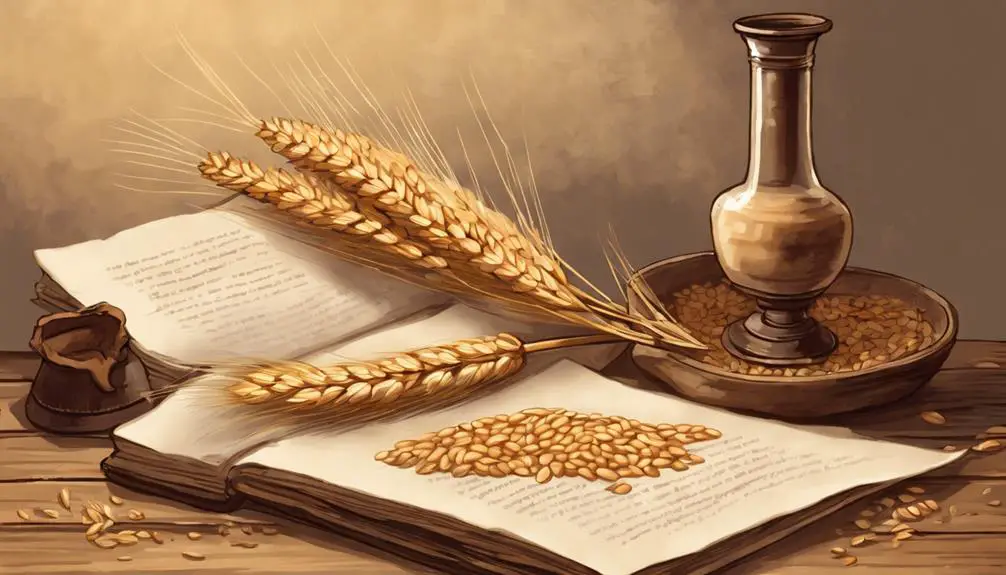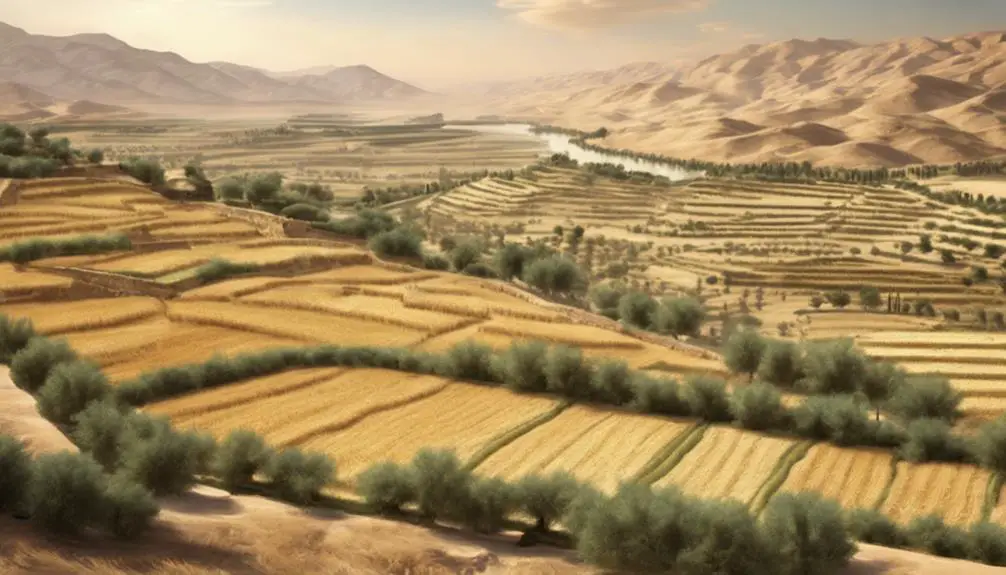Yielding no mentions of rice, the Bible's food landscape invites curiosity about its absence and the grains' historical and spiritual significance.

Rice in the Bible
Rummaging through the rich tapestry of the Bible, you'll find references to various grains, but you might be puzzled by the apparent absence of rice. This omission isn't accidental but deeply rooted in the historical and geographical context of the biblical narratives.
As you explore further, you'll discover why grains like wheat and barley take precedence, and where rice fits within the broader spectrum of world religions and its cultural significance today.
This journey into the past might just change your perspective on a grain that's become a staple in your diet, inviting you to consider its spiritual and historical dimensions.
Key Takeaways
- Rice is not mentioned in the Bible due to the specific climatic requirements for its cultivation.
- Biblical narratives focus on grains like wheat and barley that were central to the diet and agriculture of the time.
- The absence of rice reflects the historical and geographical realities of ancient civilizations mentioned in biblical stories.
- Grains in the Bible symbolize abundance and divine blessings, roles filled by locally grown crops rather than rice.
Historical and Geographical Context

Understanding the historical and geographical context of rice's mention in the Bible requires delving into the agricultural practices and trade routes of ancient civilizations in the Near East and beyond. The cultivation of rice, a staple grain for many civilizations, showcases a profound example of climate adaptation and agricultural innovation.
You see, rice's growth demands specific conditions—ample water, warm temperatures, and fertile soil—conditions that aren't universally present in the biblical landscapes traditionally associated with wheat and barley.
Thus, the presence of rice in these regions underscores a broader narrative of trade and cultural exchange. Ancient societies were adept at modifying their agricultural practices to suit their environment, but they also engaged in extensive trade networks that brought distant goods, including rice, to their doorsteps. This exchange not only enriched diets but also facilitated a cross-pollination of agricultural knowledge and techniques across continents.
The adaptation of rice cultivation in varying climates, therefore, serves as a testament to the ingenuity and resilience of these civilizations, illuminating the interconnectedness of ancient economies and ecosystems.
Grains Mentioned in the Bible

The Bible frequently references several grains, notably wheat and barley, as integral to the diets and rituals of ancient societies. These grains aren't just mentioned in passing; they're woven into the fabric of biblical narratives, symbolizing sustenance, prosperity, and divine blessings.
- Wheat Symbolism:
Wheat holds profound symbolism in the Bible. It's often associated with abundance and blessing. For instance, the Parable of the Sower uses wheat to symbolize the good seed that falls on fertile ground, representing those who hear the word and understand it, yielding a fruitful harvest.
- Barley Significance:
Barley, though considered less prestigious than wheat, carries its own significance. It was a staple for the poor and is notably mentioned in the miracle of the feeding of the five thousand, symbolizing God's provision even from the humblest of sources.
- Emotional Connection:
These grains evoke a deep emotional connection, grounding the biblical stories in the everyday realities of ancient societies, while also symbolizing spiritual truths that transcend time.
Analyzing the mention of these grains in the Bible reveals not just dietary habits, but a rich tapestry of spiritual and cultural symbolism, deeply revered and continually studied for its profound insights into human and divine interaction.
The Absence of Rice Explained

While many grains hold significant roles within the biblical narrative, rice's absence might initially seem puzzling to some readers. However, understanding the geographical and cultural contexts of the Bible sheds light on this matter. Rice cultivation, unlike that of wheat or barley, requires specific climatic conditions that weren't prevalent in the regions where the biblical stories predominantly take place. The ancient Near East, with its varied but often arid landscapes, wasn't conducive to the water-intensive cultivation of rice.
Moreover, the dietary habits of the peoples depicted in the Bible were deeply intertwined with the grains they could successfully grow and harvest. Wheat, barley, and other grains mentioned in the scriptures were staples because they adapted well to the local environment, thus becoming integral to the daily life and religious ceremonies of these communities. Rice, though a staple in many cultures today, simply wasn't a part of their agricultural or culinary reality. This absence in the scriptural texts reflects the historical and geographical realities of the times, offering a glimpse into the lives and environments of the ancient peoples.
Rice in World Religions

Across various cultures and religions, rice holds a sacred place, symbolizing prosperity, fertility, and sustenance. This grain's spiritual symbolism is deeply interwoven into the fabric of numerous religious traditions, where rice rituals serve as a conduit for expressing the most profound aspects of human experience and divine connection.
- In Hinduism, rice is pivotal in ceremonies and offerings to deities. It's considered a symbol of opulence and is integral to rituals like weddings and Pujas, where it represents abundance and well-being.
- In Buddhism, rice plays a crucial role in almsgiving and various ceremonies, symbolizing the cycle of life and the sustenance of the spiritual journey. The act of offering rice to monks is a practice laden with the intent of acquiring merit and spiritual growth.
- In Shintoism, rice is revered as a gift from the kami (spirits), embodying purity and the connection between the physical and spiritual worlds. It's used in sacred rituals to honor deities and ancestors, signifying respect, gratitude, and a deep-seated reverence for nature.
These practices highlight rice's enduring legacy as a symbol of life's cyclical nature and the sustenance of spiritual nourishment across the globe.
Cultural Significance Today

Building on its historical and religious roots, rice's cultural significance continues to evolve, mirroring changes in societal values and global interactions today. You'll find its imprint not only in the sacred texts but also in the vibrant rice festivals celebrated across various cultures. These festivals, steeped in tradition, are a testament to rice's enduring place in human society. They blend ancient rituals with contemporary concerns, such as sustainability and community welfare, reflecting a deep respect for this staple grain.
Beyond the communal celebrations, rice's role in culinary traditions showcases its versatility and adaptability. You encounter rice in a myriad of forms, from simple, comforting bowls of plain rice to intricate dishes that demand culinary mastery. Each recipe tells a story, a narrative of migration, trade, and cultural exchange, illustrating how rice has been a bridge between worlds, both past and present.
As you delve into the study of rice within the context of the Bible and beyond, you're not just exploring a food item. You're uncovering layers of human history, understanding how a simple grain can carry profound meanings, binding people across time and space. Rice continues to be a symbol of life, fertility, and prosperity, echoing its biblical significance into today's cultural practices.
Frequently Asked Questions
How Has the Nutritional Value of Rice Been Perceived Historically in Comparison to the Grains Mentioned in the Bible?
You're exploring how rice's nutritional value stacks up against historical grains, without delving into biblical references. Rice genetics have evolved, making it a staple in modern diets, often viewed as more versatile and adaptable than ancient grains.
Historically, grains in the Bible were prized for their sustenance, but rice, with its genetic advancements, offers a broader nutritional profile, fitting seamlessly into diverse diets worldwide, reflecting its growing significance in nourishment and cultural practices.
Are There Any Biblical Parables or Stories That Might Symbolically Relate to Rice, Even if Rice Is Not Directly Mentioned?
You won't find rice directly mentioned in biblical texts, but you can uncover layers of rice symbolism through agricultural metaphors present in parables and stories. These narratives often explore themes of growth, sustenance, and the cycle of life—concepts that rice, as a staple grain, embodies.
Analyzing these texts, you'll appreciate how rice might symbolically fit within the broader context of biblical teachings, even in its absence from the scripture.
How Did Rice Cultivation Methods Differ in Ancient Times Compared to the Cultivation of Grains Mentioned in the Bible?
You're exploring how ancient rice cultivation methods contrast with those of grains mentioned in the Bible.
Ancient irrigation played a crucial role in rice farming, more so than for biblical grains, which relied on natural rainfall.
Seed selection for rice was also more deliberate, aiming to improve crop resilience and yield.
These practices underline a sophisticated understanding of agriculture, reflecting the adaptability and innovation of ancient farmers in different ecological contexts.
Has the Absence of Rice in the Bible Influenced Modern Dietary Laws or Restrictions Within Religious Communities?
You're exploring how the absence of rice from ancient texts has shaped modern dietary laws and restrictions within religious communities.
It's fascinating to see how cultural influences and modern adaptations have weaved into traditions, altering what's considered sacred or profane in diets.
This absence hasn't directly altered laws but has subtly influenced the inclusion of rice in religious practices, showcasing a blend of historical adherence and contemporary dietary evolution within these communities.
What Role Does Rice Play in Contemporary Religious Ceremonies or Rituals That Have Adapted Over Time, Despite Its Absence in Ancient Religious Texts?
You're exploring how rice, despite not being mentioned in ancient texts, plays a significant role in modern religious ceremonies. Its symbolism and incorporation into rituals reflect adaptation over time. Rice embodies prosperity, fertility, and sustenance, weaving through various faiths' practices.
As you delve into its usage, you'll find rice has transcended its culinary boundaries, embedding itself in the spiritual fabric of communities, enriching modern rituals with layers of meaning and tradition.
Conclusion
In conclusion, while rice doesn't prominently feature in the biblical narrative, its absence speaks volumes about historical and geographical contexts of the times. The grains mentioned, such as wheat and barley, underline the agrarian lifestyle of the ancient Near East.
Rice's significance in other world religions and its cultural importance today highlight the diversity of human sustenance and spirituality. This exploration reveals the intricate ways in which food, faith, and culture are interwoven, reflecting the rich tapestry of human history and belief.



Sign up